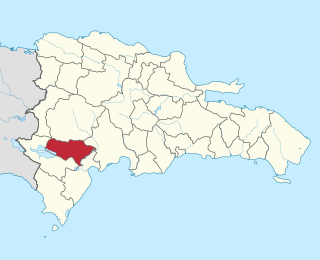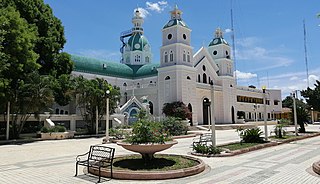
Azua is a province which is collectively one of the thirty-two provinces of the Dominican Republic. It is divided into 10 municipalities and its capital city is Azua de Compostela. It is bordered by the provinces of La Vega to the north-east, San José de Ocoa and Peravia to the east, Barahona and Baoruco to the west and San Juan to the north-west. To the south, Azua has a significant coastline of the Caribbean Sea.

Baoruco, alternatively spelt Bahoruco, is a province of the Dominican Republic located in the southwest of the country, part of the Enriquillo Region, along with the provinces of Barahona, Independencia and Pedernales. Before 1952 it included what is now Independencia Province.

Jimaní is the capital and the second largest city of the Independencia Province of the Dominican Republic. It serves as one of the two main border crossings to Haiti, with a duty-free open-air marketplace operating on the border with Haiti. The town suffered damages in the flash flood of May 25, 2004, which killed many citizens during the night and washed away hundreds of homes.

Vicente Noble is a municipality in Barahona province in the Dominican Republic.

Duvergé, also known locally as Las Damas is the largest city in the province of Independencia in the Dominican Republic. The first settlers of this community were the gentlemen Christopher Pérez and María del Pulgar, originating from San Juan de la Maguana.

San Juan de la Maguana is a city and municipality in the western region of the Dominican Republic, and capital of the San Juan province. It was one of the first cities established on the island; founded in 1503 and was given the name of San Juan de la Maguana by San Juan Bautista and the Taino name of the valley: Maguana. The term Maguana means "the first stone, the unique stone".

San José de las Matas, also known as Sajoma, is an important municipality (municipio) of the Santiago province in the Dominican Republic. The mayor of Sajoma is Roberto Espinal. there has been many positive changes in the last four years such as adding a 911 system. Within the municipality there are three municipal districts : El Rubio, La Cuesta and Las Placetas.

El Cercado is a town in the San Juan province of the Dominican Republic.
Señorita República Dominicana 1979 was held on December 20, 1978. There were 28 candidates who competed for the national crown. The winner represented the Dominican Republic at the Miss Universe 1979. The Señorita República Dominicana Mundo entered Miss World 1979.
Señorita República Dominicana 1978 was held on December 14, 1977. There were 28 candidates who competed for the national crown. The winner represented the Dominican Republic at the Miss Universe 1978. The Señorita República Dominicana Mundo will enter Miss World 1978. Only contestants for 27 provinces and one municipality entered. For the top 10 they showed their evening gown and answered questions so they could go to the top 5. In the top 5 they answered more questions.
Señorita República Dominicana 1976 was held on February 23, 1976. There were 28 candidates who competed for the national crown. The winner represented the Dominican Republic at the Miss Universe 1976. The Virreina al Miss Mundo will enter Miss World 1976. Only the 27 province, 1 municipality entered. On the top 10 they showed their evening gown and answered questions so they could go to the top 5. In the top 5 they would answer more questions.
Señorita República Dominicana 1973 was held on January 29, 1973. There were 28 candidates who competed for the national crown. The winner represented the Dominican Republic at the Miss Universe 1973. The Virreina al Miss Mundo entered Miss World 1973. Only 27 provinces and 1 municipality entered. The top 10 contestants paraded in evening gowns and answered questions to select the top five, who then answered more questions.
Señorita República Dominicana 1972 was held on March 1, 1972. There were 28 candidates who competed for the national crown. The winner represented the Dominican Republic at the Miss Universe 1972. The Virreina al Miss Mundo will enter Miss World 1972. Only the 27 province, 1 municipality entered. On the top 10 they showed their evening gown and answered questions so they could go to the top 5. In the top 5 they would answer more questions.
Señorita República Dominicana 1970 was held on January 24, 1970. There were 28 candidates who competed for the national crown. The winner represented the Dominican Republic at the Miss Universe 1970. The Virreina al Miss Mundo will enter Miss World 1970 and Miss International 1971. Only the 27 province, 1 municipality entered. On the top 10 they showed their evening gown and answered questions so they could go to the top 5. In the top 5 they would answer more questions.
Señorita República Dominicana 1965 was held on February 20, 1965. There were 26 candidates who competed for the national crown. The winner represented the Dominican Republic at the Miss Universe 1965. Only the 25 province and 1 municipality entered. On the top 10 they showed their evening gown and answered questions so they could go to the top 5. In the top 5 they would answer more questions.
Señorita República Dominicana 1962 was held on January 29, 1962, when 26 candidates competed for the national crown. The winner represented the Dominican Republic at the Miss Universe 1962. The first runner up would enter Miss International 1962. Only the 25 provinces and 1 municipality entered. The top ten contestants wore evening gowns and answered questions to get through to the top 5, where they answered more questions.

The Dominican city of Santa Cruz de Mao, or simply Mao, is the head municipality of the Valverde province, in the northwest of the country.

San Juan is a province of the Dominican Republic. Before 1961 it was known as Benefactor. San Juan is the Republic's largest province, bearing a size of 3,569 square kilometers, and it is landlocked.

Sabana Yegua is a municipality (municipio) of the Azua province in the Dominican Republic.







